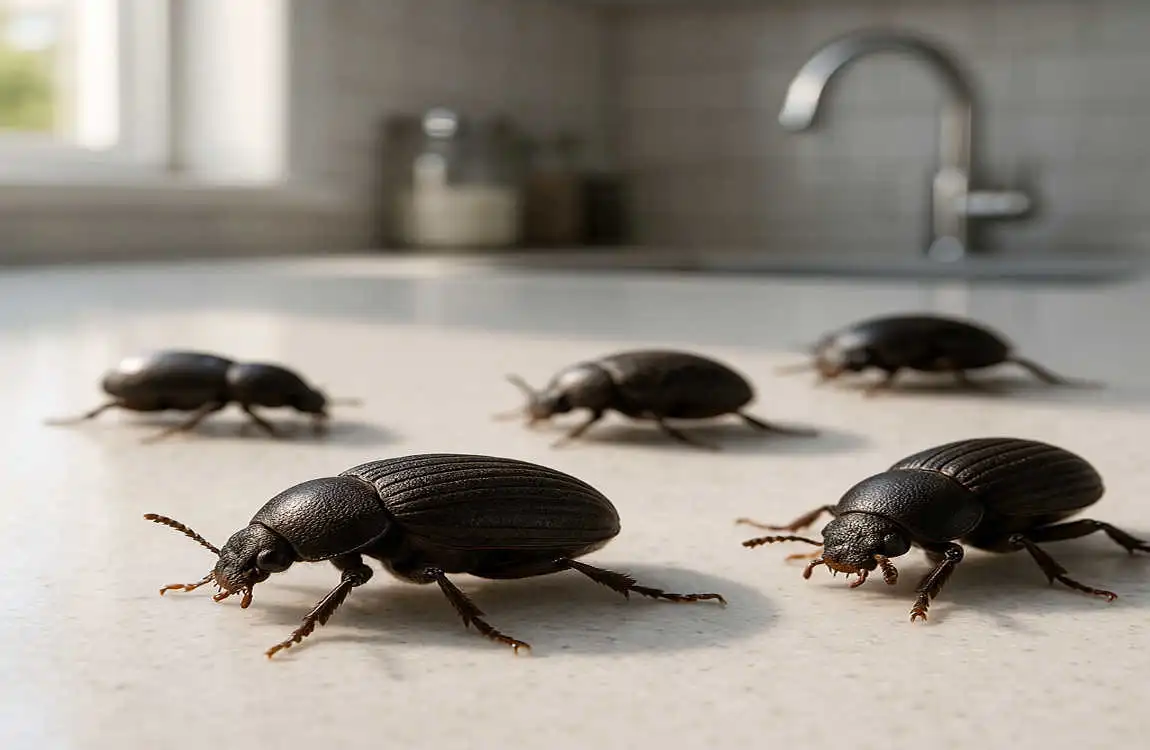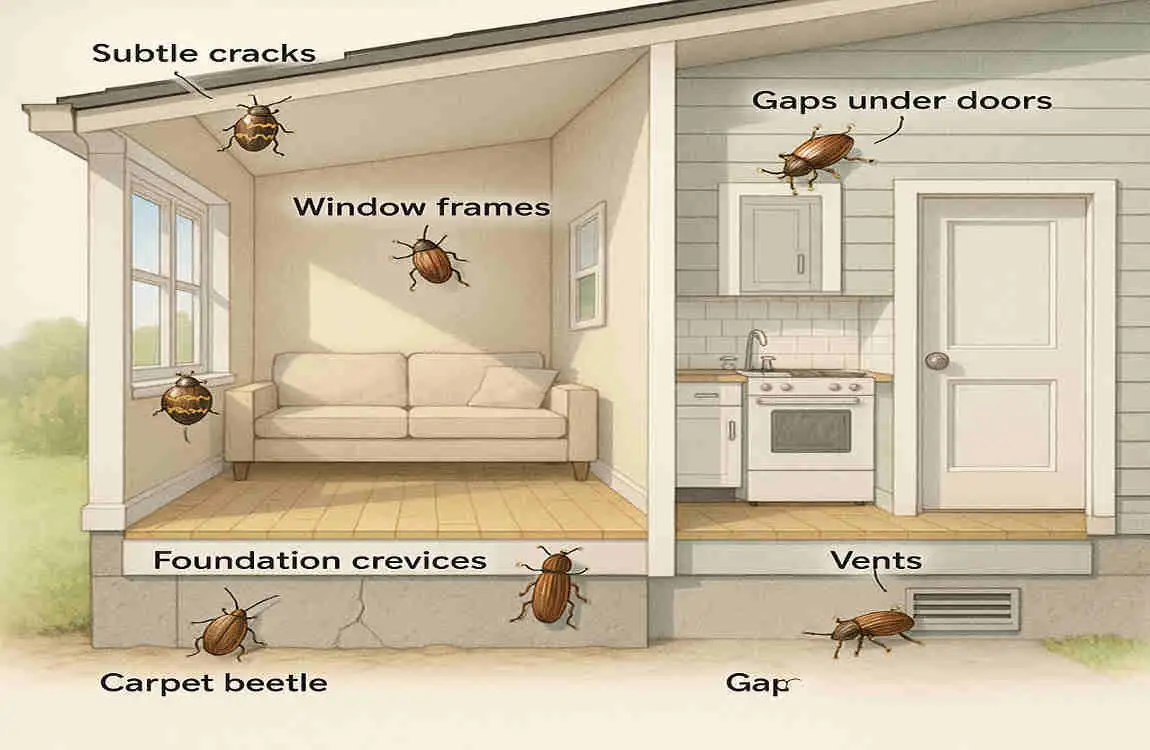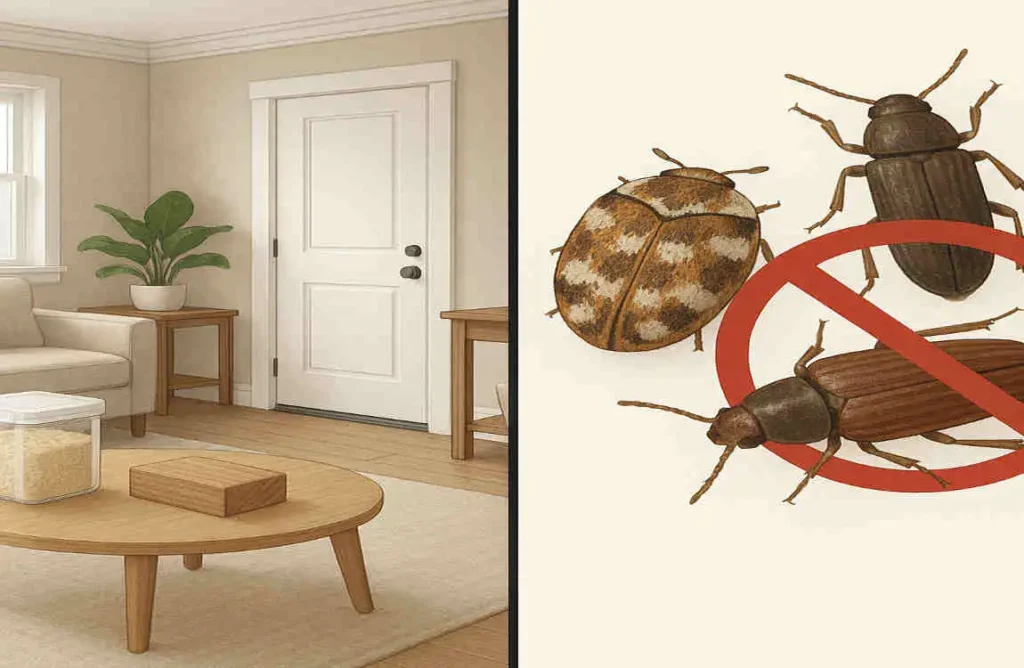Finding beetles in your spotless home can be incredibly frustrating. You’ve spent hours cleaning, scrubbing, and tidying, only to discover these unwelcome guests crawling around your living space. If you’re wondering, “Why are there beetles in my house?” you’re not alone. Many homeowners face this perplexing problem, and it’s crucial to understand that the presence of beetles doesn’t necessarily reflect your housekeeping skills.
Understanding Beetles and Their Behavior

Before we tackle the question of why beetles invade clean homes, let’s take a closer look at these tiny creatures. Some of the most common types of beetles found in homes include:
- Carpet beetles
- Drugstore beetles
- Flour beetles
- Grain beetles
- Larder beetles
Beetles are fascinating insects with unique biology and behaviors. They are attracted to homes for various reasons, such as:
- Seeking shelter from harsh outdoor conditions
- Searching for food sources
- Looking for a suitable place to lay eggs
Seasonal and environmental factors can also influence the intrusion of beetles. For example, during colder months, beetles may seek the warmth and comfort of your home. It’s important to note that the presence of beetles doesn’t necessarily indicate a lack of cleanliness. While clutter and dirt can attract some types of beetles, even the most well-maintained homes can experience beetle invasions.
Why Are There Beetles in My House?
Now, let’s address the burning question: why do beetles appear in clean houses? Despite your best efforts to keep your home spotless, beetles can still find their way inside. Here are some reasons why:
- Attractants other than dirt or clutter: Beetles are drawn to various factors besides messiness. Light, warmth, and moisture can all serve as powerful attractants for these insects. For example, outdoor lighting near your home’s entrances can lure beetles inside.
- Hidden food sources: Even in a clean house, there may be hidden food sources that beetles can exploit. Tiny crumbs lodged in carpet fibers, forgotten food remnants in rarely-used appliances, or even the glue in book bindings can provide sustenance for beetles.
- Structural entry points: Beetles can enter your home through various structural openings, such as cracks, gaps, and crevices in walls, windows, and doors. These entry points may be difficult to detect and can allow beetles to sneak inside unnoticed.
Common Entry Points for Beetles in a Clean Home

To effectively prevent beetle infestations, it’s crucial to identify and seal common entry points. Here are some areas to focus on:
- Cracks, gaps, and crevices: Inspect your home’s exterior and interior for any cracks, gaps, or crevices in walls, windows, and doors. Pay special attention to areas where utilities enter your home, such as pipes and wires.
- Vents and openings: Check your home’s ducts, including those in the attic, crawl space, and foundation. Ensure that they are properly sealed and covered with screens to prevent entry by beetles.
- Laundry and storage areas: Beetles can often be found in laundry rooms and storage areas, particularly in spaces that are warm and humid. Keep these areas clean, dry, and well-ventilated to discourage beetle activity.
- Pet food and plants: Beetles can be attracted to pet food and indoor plants. Store pet food in sealed containers and regularly inspect your plants for signs of beetle presence.
How to Identify and Diagnose Beetle Infestation
Knowing how to identify and diagnose a beetle infestation is essential for adequate control. Here are some signs to look out for:
- Beetle droppings: Small, dark-colored droppings can indicate the presence of beetles. These droppings may resemble coffee grounds or sand.
- Damage: Beetles can cause damage to fabrics, carpets, books, and other materials, often leaving behind holes, frayed edges, or unusual wear patterns.
- Sightings: Regularly inspect your home for live beetles or their shed skins. Pay close attention to areas where beetles are likely to hide, such as dark corners, closets, and storage boxes.
Proper identification is crucial for targeted control. Different types of beetles may require specific treatment methods. If you’re unsure about the kind of beetle in your home, consider consulting with a pest control professional for accurate identification and guidance.
Proven Methods to Keep Beetles Out of Your Clean House
Now that we’ve explored why beetles may appear in clean homes and how to identify an infestation, let’s dive into practical solutions to keep these pests at bay. Here are some proven methods:
- Regular cleaning beyond the obvious: In addition to your usual cleaning routine, focus on often-overlooked areas where beetles may hide or find food. Vacuum carpets, upholstered furniture, and curtains thoroughly to remove dust and debris. Clean behind appliances, in cupboards, and along baseboards.
- Home sealing and maintenance: Seal any cracks, gaps, or crevices in your home’s structure to prevent beetle entry. Use caulk or weatherstripping to close off potential entry points around windows, doors, and utility openings. Regularly inspect and repair any damage to your home’s exterior.
- Natural repellents and deterrents: Certain natural substances can effectively repel beetles. Consider using essential oils like peppermint, citronella, or tea tree oil. Place sachets filled with dried herbs such as bay leaves, cloves, or lavender in closets and storage areas.
- Proper storage techniques: Store food items, including pet food, in airtight containers to prevent spoilage and contamination. Use sealed plastic bins or garment bags to protect clothing and fabrics from beetle infestations. Regularly inspect and clean storage areas to prevent the attraction of beetles.
- Outdoor area management: Keep your home’s exterior surroundings clean and tidy. Remove leaf litter, dead plants, and other organic debris that may attract beetles. Trim vegetation and ensure proper drainage to reduce moisture levels around your home’s foundation.
Method Description
Regular cleaning: Vacuum carpets, upholstery, and curtains; clean behind appliances and in cupboards.
Home sealing and maintenance: Seal cracks, gaps, and crevices; repair damage to the home’s exterior.
Natural repellents: Use essential oils like peppermint or citronella, and place sachets with dried herbs.
Proper storage: Store food in airtight containers and use sealed bins or garment bags for clothing.
Outdoor area management: Remove leaf litter and debris, trim vegetation, and ensure proper drainage to maintain a well-maintained outdoor space.
Professional Solutions and When to Call an Exterminator
While DIY methods can be effective in managing beetle infestations, there may be times when professional help is necessary. If you’ve tried various cleaning home remedies and still can’t seem to get rid of the beetles, or if the infestation is severe, it’s time to call in the experts.
Professional pest control services possess the knowledge, experience, and tools necessary to effectively tackle stubborn beetle infestations. They can:
- Conduct a thorough inspection to identify the type of beetle and the extent of the infestation.
- Develop a customized treatment plan based on your home’s specific needs.
- Utilize specialized products and techniques to effectively eliminate beetles.
- Provide ongoing monitoring and prevention services to keep your home beetle-free.
Scheduled inspections and treatments can provide long-term protection against beetle infestations. Professional exterminators can identify potential risk factors and implement proactive measures to prevent future problems.
Preventive Measures for Long-Term Beetle Control
Preventing beetle infestations is much easier than dealing with an active infestation. Here are some preventive measures to incorporate into your home maintenance routine:
- Seasonal home maintenance checklist: Create a seasonal checklist that includes tasks such as inspecting and sealing entry points, cleaning gutters, and checking for signs of beetle activity. Regularly completing these tasks can help prevent infestations of beetles.
- Monitoring beetle activity: Keep an eye out for signs of beetle presence, such as droppings, shed skins, or live sightings. Early detection enables prompt intervention and can prevent a minor issue from developing into a full-blown infestation.
- Environmental adjustments: Make your home less inviting to beetles by controlling moisture levels, sealing food sources, and reducing clutter. Use dehumidifiers in damp areas, store food properly, and regularly declutter your living spaces.
